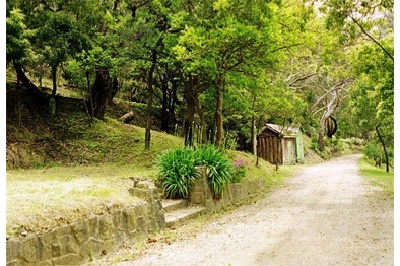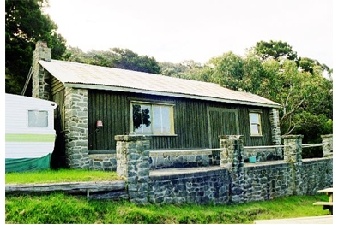WWII Air Spotters' Cabin
20 Armytage Street, LORNE VIC 3232 - Property No 121930
-
Add to tour
You must log in to do that.
-
Share
-
Shortlist place
You must log in to do that.
- Download report





Statement of Significance
Queen's Park Caravan Park is of local significance for its historical and social values. It has been a highly valued recreational feature within the local area for more than a century (criteria A4, G1). The significance of the park is embodied in the physical fabric and setting, whereby the natural bushland and contours has been conformed into a terraced landscape with gravelled tracks and stone walls.
Within the park, the former Air Spotters' Quarters has local significance an example of volunteer air spotters' quarters established at Lorne as a community response to fears of attack by sea during the Second World War. It is also of architectural significance as an example of 'rustic park design' or 'parkitecture', a design strongly influenced by the US National Parks Service and characterised by the use of local materials to complement the natural environment. Buildings and structures took on a deliberately rustic character as a result of this design influence. It is one of several examples within the Shire (including the Great Ocean Road arch, Lorne Kiosk and Cumberland River picnic shelter) and one of a small number of examples state-wide (eg. Yarra Bend Golf House) (criteria A4, G1). Although it has been altered slightly in recent years, the original character and appearance of the building is clearly discernible.
Significant fabric includes: terraced layout, stone walls, the former Air Spotters' Quarters and two small buildings near the main entrance (one styled as a log cabin and the other is reminiscent of a bathing box).
-
-
WWII Air Spotters' Cabin - Physical Description 1
Queen's Park Caravan Park occupies part of Queen's Park. It is a large caravan and camping park surrounded by bushland, with views to the sea and Point Grey. The terraced nature of the park is identified by the gravelled tracks that follow the contours of the land, together with some stone wallling and exotic plantings. In addition to the expected caravan and camping sites and amenities, it also contains several interesting buildings (the Air Spotters Quarters is described below) and two small buildings near the main entrance which are of interest: one is styled as a log cabin, and the other is reminiscent of a small bathing box. The use and history of these two buildings is not known. All of the buildings appear to have been designed by the Public Works Department in the late 1930s, following the popular and influential rustic Bungalow designs by the early 20th century National Park Service architecture in the U.S.A.
The Air Spotter's Quarters is a timber building (c.1934?) set on a rise within the grounds of the Queen's Park Caravan Park, with views over the sea and Point Grey. The building is characterised by a gable roof form and vertical timber cladding with random stone base, retaining walls and piers, with an elevated balcony on the seaward side. There is a random stone chimney at one end. There have been some recent changes to the building, including the balcony. The design and construction of the former Air Spotter's Quarters has an affinity with the Lorne Kiosk (former Comfort Station) on the Lorne foreshore, and the picnic shelter in the Cumberland River Caravan Park.
WWII Air Spotters' Cabin - Historical Australian Themes
Local themes - Defence & Governing the Shire
WWII Air Spotters' Cabin - Integrity
Good
WWII Air Spotters' Cabin - Physical Description 2
Key element - building
WWII Air Spotters' Cabin - Physical Description 3
Extent of designation - The whole of Queens Park Caravan Park.
WWII Air Spotters' Cabin - Usage/Former Usage
Public
Veterans Description for Public
WWII Air Spotters' Cabin - Veterans Description for Public
The Air Spotters Quarters is located within the Queen's Park Caravan Park, on 20 Armytage Street. The park is thought to have been established around 1937. The Air Spotters Quarters, a building of rustic design, was originally constructed as a park recreation hut. During the Second World War, it was used as Air Spotters Quarters. Throughout the war,Volunteer Air Observers carried out "air spotting" at Surf Coast Shire's coastal towns to safeguard against a feared attack by sea.
Heritage Study and Grading
Surf Coast - Surf Coast Places of Cultural Significance Study
Author: Context Pty Ltd with assistance from Dr Carlotta Kellaway with later assessments added by Dr David Rowe
Year: 2003
Grading:
-
-
-
-
-
LEIGHWOOD
 Victorian Heritage Register H0604
Victorian Heritage Register H0604 -
JURA
 Victorian Heritage Register H0822
Victorian Heritage Register H0822 -
Pacific Hotel
 National Trust
National Trust
-
1) ST. ANDREWS HOTEL AND 2) CANARY ISLAND PALM TREE
 Nillumbik Shire
Nillumbik Shire
-
-












